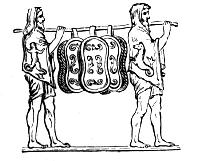This article includes a list of general references, but it lacks sufficient corresponding inline citations. (March 2013) |
The Carmen Saliare is a fragment of archaic Latin, which played a part in the rituals performed by the Salii (Salian priests, a.k.a. "leaping priests") of Ancient Rome.[1] There are 35 extant fragments of the Carmen Saliare, which can be read in Morel's FPL.[2]


The rituals revolved around Mars and Quirinus, and were performed in March and October. These involved processions in which they donned archaic armour and weapons, performed their sacred dance, and sang the Carmen Saliare. As a body they existed before the founding of the Roman Republic, tracing their origin back to the reign of Numa Pompilius. The Salian priests were chosen from the sons of patrician families whose parents were still living. They were appointed for life, though they were allowed to resign from the Salian priesthood if they achieved a more prestigious priesthood or a major magistracy.
In the Annales written by Roman historian Tacitus, it is revealed that several Romans proposed the name of Germanicus to be added to the Salian Song, as a memory of his virtue and goodwill.
Fragments
editTwo fragments which have been preserved by Marcus Terentius Varro in his De Lingua Latina, 7.26, 27 (fragment 2 and 1 by Maurenbrecher's numbering):[3]
| Latin (ed. C. O. Muellerus) |
|
| Latin (ed. A. Spengel) |
|
| Latin (ed. R. G. Kent) |
|
| English translation (ed. R. G. Kent) |
The mysterious cozeulodorieso has attracted several proposals. Julius Pomponius Laetus proposed in his editio princeps the interpretation osculo dolori ero "I shall be as a kiss to grief", though his emendations are now dismissed as "editorial fantasy".[4] George Hempl restored it more carefully to coceulod orieso, attested in some manuscripts aside from the spacing, which is good archaic Latin for classical cucūlō oriēre "(thou shalt) come forth with the cuckoo".[5]
A fragment preserved by Quintus Terentius Scaurus in his De orthographia (fragment 6 by Maurenbrecher's numbering):[6]
| Latin (ed. H. Keilius) | † cuine ponas Leucesiae praetexere monti quot ibet etinei de is cum tonarem. |
| Theodor Bergk's conjectured reconstruction | Cúme tonás, Leucésie, práe tét tremónti, Quóm tibeí cúnei décstumúm tonáront |
An excerpt of it:[7]
| Latin with metre indicated | cumé tonás, Leucésie, praé tét tremónti |
| Rendering in classical Latin | cum tonas, Luceti, prae te tremunt |
| English translation | When thou thunderest, O god of Light (Jupiter), men tremble before thee |
See also
editNotes
editReferences
edit- ^ Clifford Ando; Jörg Rüpke (2006). Religion and Law in Classical and Christian Rome. Franz Steiner Verlag. pp. 18–. ISBN 978-3-515-08854-1.
- ^ FPL=Fragmenta poetarum latinorum epicorum et lyricorum: praeter enni annales et Ciceronis Germanicique Aratea, originally compiled by W. Morel 1927, 2nd edition by C. Büchner 1982, 3rd and 4th editions by J. Blänsdorf in 1995 and 2011.
- ^ Marcus Terentius Varro, de lingua latina:
- M. Terenti Varronis de lingua latina libri qui supersunt ex codicum vetustissimarumque editionum auctoritate integra lectione adiecta recensuit Leonhardus Spengel Berolini, sumtibus Dunckeri et Humboltii – MDCCCXXVI [1826], pp. 312, 314
- M. Terenti Varronis de lingua latina librorum quae supersunt emendata et annotata a Carolo Odofredo Muellero anno MDCCCXXXIII [1833], pp. 129–30
- Terenti Varronis de lingua Latina libri emendavit apparatu critico instruxit praefatus est Leonardus Spengel. Leonardo patre mortuo edidit et recognovit filius Andreas Spengel. Berolini apud 1829 (Google)
- M. Terenti Varronis de lingua latina quae supersunt recensuerunt Georgius Goetz et Fridericus Schoell accedunt grammaticorum Varronis librorum fragmenta Lipsiae in aedibus B. G. Teubneri MCMX [1910], pp. 100f.
- Varro on the Latin language with an English translation by Roland G. Kent In two volumes I Books V.–VII., 1938, pp. 292–95
- ^ Sarullo, Giulia; Taylor, Daniel J. (December 2013). "Two Fragments of the Carmen Saliare and the Manuscript Tradition of Varro's De Lingua Latina". Codices Manuscripti & Impressi. 91/92: 1–10.
- ^ Hempl, George (1899). "The Origin of the Latin Letters G and Z". Transactions and Proceedings of the American Philological Association. 30. The Johns Hopkins University Press: 24–41. doi:10.2307/282560. JSTOR 282560.
- ^ Q. Terentii Scauri liber de orthographia; in: Grammatici latini ex recensione Henrici Keilii Vol. VII Scriptores de orthographia […] Lipsiae in aedibus B. G. Teubneri MDCCCLXXX [1880], p. 28. For Theodor Bergk's conjectured reconstruction compare also:
- Indices lectionum et publicarum et privatarum, quae in Academia Marburgensi per semestre hibernum inde a D. XXV. M. Octobris MDCCCXLVII [1847] usque ad D. XXV. M. Martii MDCCCXLVIII [1848]. Habendae proponuntur. — Inest Theodori Bergkii Commentatio De Carminum Saliarium reliquiis. Marburgi. Typis Elwerti Academicis, pp. XII, XIV ( google])
- Opuscula philologica Bergkiana edidit Rudolfus Peppmüller. Volumen I. Ad Latinas literas spectantia. Halis Saxonum, in Orphanotrophei libraria. MDCCCLXXXIV. – Kleine philologische Schriften von Theodor Bergk. Herausgegeben von Rudolf Peppmüller. I. Band. Zur römischen Literatur. Halle a. S., Verlag der Buchhandlung des Waisenhauses. 1884, pp. 492, 494 (google-US)
- ^ Elegiac poems of Ovid edited by J. W. E. Pearce. Vol. II The Roman Calendar Selections from Fasti, Oxford, 1914, p. 146 (IA)
External links
edit- B. Maurenbrecher:
- Carminum Saliarium reliquiae edidit B. Maurenbrecher; in: Jahrbücher für classische Philologie. Herausgegeben von Alfred Fleckeisen. Einundzwanzigster Supplementband. Mit einer Karte. Druck und Verlag von B. G. Teubner, Leipzig, 1894, p. 313ff. (IA)
- Carminum Saliarium reliquiae edidit B. Maurenbrecher. Commentatio ex supplemento uno et vicesimo Annalium Philologicorum seorsum expressa. Lipsiae in aedibus B. G. Teubneri. MDCCCXCIV [1894] (IA)
- George Hempl:
- III.—The Origin of the Latin Letters G and Z. By Prof. George Hempl, in: Transactions and Proceedings of the American Philological Association. 1899. Volume XXX, pp. 26 & 39f. (JSTOR):
- XII.—The Salian Hymn to Janus. By Prof. George Hempl, in: Transactions and Proceedings of the American Philological Association. 1900. Volume XXXI, pp. 182ff. (JSTOR, IA, google-US)
- Carmen Saliare (Bibliotheca Augustana)